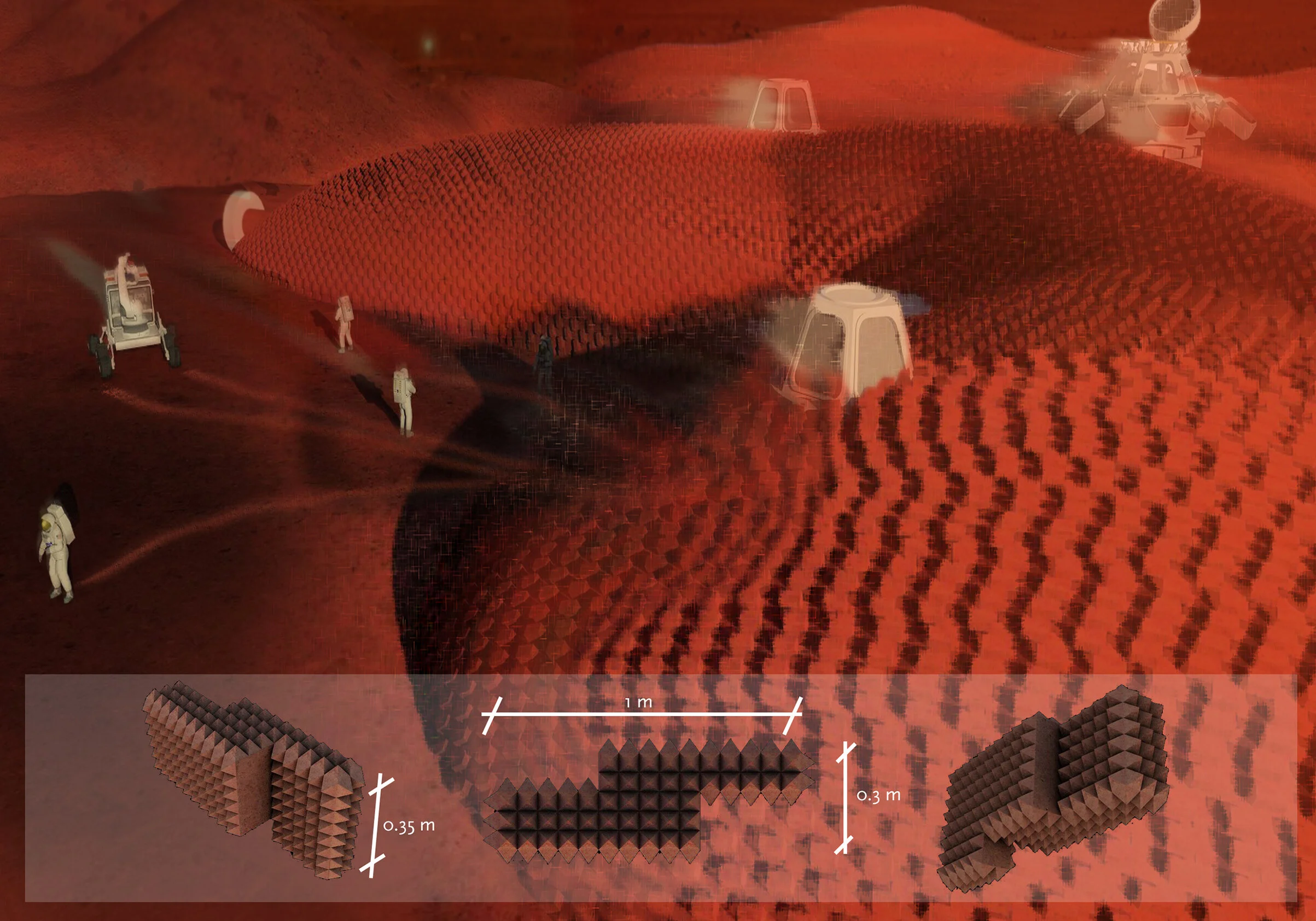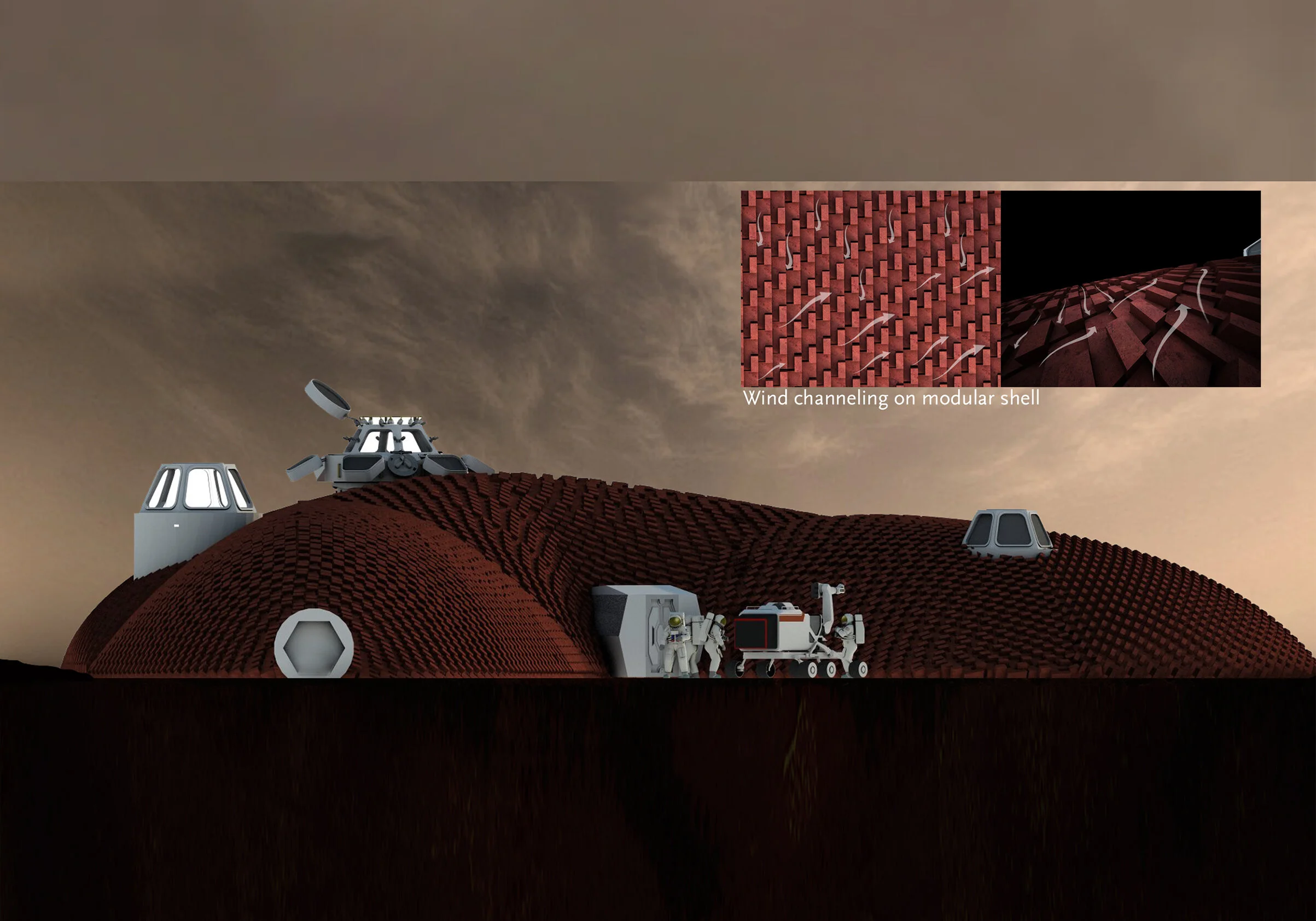HumanxOuterSpace Future Living —
Modular Mars
Habitable Shelter on Planet Mars
CHALLENGE
Building in outer space is a very expensive task. To ensure housing in space, one must learn how to use the existing materials in these regions. Main objective and challenge is to build the largest safe and spacious volume with the least weight of materials transported from Earth to Mars.
SOLUTION
Modular Mars is a multipurpose innovative habitat made out of Martian soil. By relying on in-situ resources, transported materials from Earth to Mars can be restricted to life support systems and vehicles. The habitat is designed to withstand Mars' extreme cold, high radiation levels, lack of oxygen and frequent dust storms as well as to ensure the psychological well-being of the crew.
CONTEXT
American University of Beirut (AUB)
in collaboration with Harvard Business
School Aerospace Alumni Group (HBSAAG)
TAGS
Outer Space Living,
Extreme Environments
Site Analysis —
Research01 *





Site Analysis
As a first step in our process, we analyzed the terrains and possible sites on Planet Mars to identify the best location to build our base. We particularly studied the wind direction, the magnetic field, the thermal inertia of the soil and the availability of minerals and water.
After our analysis, we chose Arabia Terra as the main location.
Site Selection
ARABIA TERRA
Location: 26.7°N, 63°E
Site Factors


Form —
Volumetric Development02 *



Form Finding
We analyzed the wind flow and landscape formation on our site as an evidence of bidirectional wind and low thermal inertia and as a tool to generate the form.
Form Development
The aerodynamic form prevents turbulence, erosion and dust storm formation.


Concept —
Space Organization03 *
Function Distribution
The plan shows a large spacious living space, a necessity for the psychological health of the crew.
Yet, being in a confined space, no matter how spacious it is, will eventually affect a person psychologically. Working with plants can increase the psychological well-being of individuals.
The Greenhouse
The main circulation within the plan becomes through the greenhouse. The intersection of the greenhouse with the habitable spaces creates a green strip within the “cave” where people not only harvest crops but also interact, practice activities and spend time either working or relaxing in the spacious garden.
Module Design —
Construction Technique04 *
Material
To ensure a cost-efficient approach, the exterior shell is composed of martian regolith, a clay mineral that occurs naturally on Mars' surface. It acts as a solar radiation shield.
Woodless Construction Technique
The outer shell is composed of 6 smaller shells connected together. Technique is based on catenary contours.
MOLDO: The Molding Rover
The rover will be sent to Mars two years prior to the crew's arrival. Rover is programmed to place bricks, each at accurate coordinates. After habitat construction, MOLDO will still be used by astronauts to move objects, for transportation and for discovery of terrains.
The Module
The modules are thick enough to provide protection from radiation. The connection between the modules is based on the interlocked joint and on the "friction ridges" on the surface. Since no mortar will be used, these modules are interlocked and crushed together to produce, from the “ridges” on them, a “mortar-like” friction layer that keeps them in place.Wind Channels
On the surface, wind channels are created by the shape of the module. These channels are oriented to channel away two major prevailing winds. They are necessary to decrease the erosion effect of the multi-directional wind shear hitting the surface.


Light Distribution & Interior Ambiance
Interior Distribution of Light from Cupolas
Details
Cupola Detail Section
Airlock Detail Section
Habitat Detail Section
Physical Model —
Model05 *
HumanxOuterSpace Future Living —
Hybrid Skins
Extraterrestrial Interventions
CHALLENGE
Environmental conditions on planet Mars have put forward a need for designing innovative spacesuits which lead to super human capabilities. The spacesuit design derives from research into the natural ecology of Mars and from research visits to Wadi Rum and Petra in Jordan.
SOLUTION
The spacesuit proposed aims to maintain the body for long-term missions on Mars through responding to the changes the body undergoes and by replicating Earth’s gravity effects on the circulatory system of the body. It also has a protective layer, a “dust storm airbag” layer, which responds to the sudden dust storms that constantly strike Mars’s surface by inflating into a hard protective temporary shell.
CONTEXT
Mars - Extraterrestrial Interventions
Architectural Association (AA) Visiting
School in Amman, Jordan
2017
More Information
INSTRUCTORS
Julia Koerner & Kais Al-Rawi
TEAM
Dana Halasa,
Jhila Prentis
Problem Space —
Research01 *
Our initial step was to research and understand body reactions to prolonged periods of time in outer space.
Changes in Body Proportion
Upper part of body inflates due to low gravity
Changes in Blood Circulation
Blood flows up the body due to decrease in gravity from Earth to Mars
Identifying Opportunity —
Concept02 *
Overlapping Changes to Identify Most Critical Zones
Constraining blood circulation in lower legs becomes essential to maintain regular, earth-like conditions
Study of Body Articulations
Understanding joinery to add force into these areas is essential to keep muscle strength in legs
Site Analysis —
Site as Inspiration03 *
Morphology of the Site
In the geological formations found on the surface we can find a layering of surfaces.
A rougher top layer which is constantly shifting and responding to the the external environment, sits almost like a protective shell over a smoother layer which remains relatively unchanged.
The properties of the ribbons and pockets formed on the surface by the martian environment can be interpreted as a double layered skin.
The pattern and concept design of the suit is inspired from this layering of the Martian sand dunes and their morphology.
4 Main Layers —
Main Components04 *
Overall Performance
With time, the suit permits evolution to take place by allowing the body to adapt to Martian conditions rather than preserving it.
Through its 4 main layers, the suit allows the body to undergo the changes in a gradual way until it undergoes full transition. As time passes, less constraints on the leg area is required.



Motion Layer
Ensuring movement by developing different joinery patterns
Resistance Layer
Resistance layer replicates the force exerted by earth’s gravity on our muscles to ensure leg muscle strength remains intact for as long as possible
Force of Gravity on Earth = Resistance in Movement in Spacesuit
Compression Layer
The bulbous elements massage the legs and stimulate blood flow
Shell Layer
AN “AIRBAG” SYSTEM
The temporary shelter layer responds to sudden dust storms.
Sensors in its outer layer detect changes in external environment and trigger inflation of the shell.






















